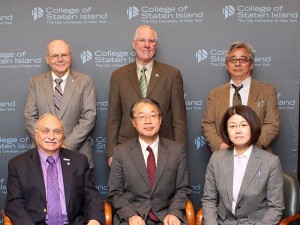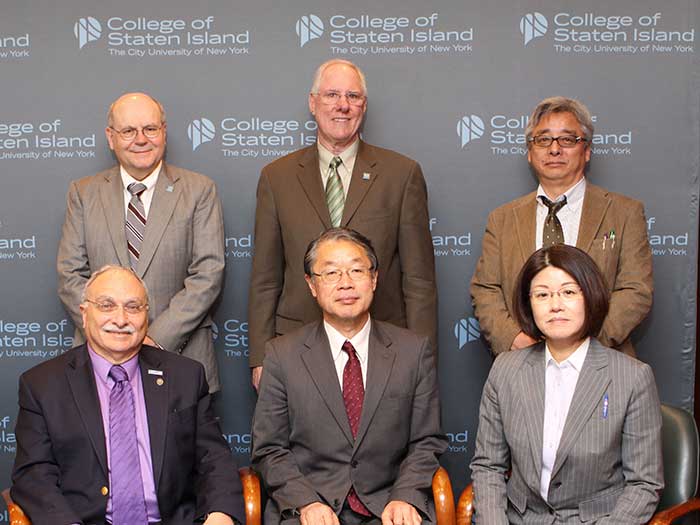 With much of the Japanese coast at or below sea level, officials from Japan’s Ministry of Land, Infrastructure, Transport, and Tourism are always seeking new ideas for response and planning regarding natural disasters, to learn new ways to save lives should their country suffer another tsunami such as the one experienced in 2011 that killed more than 15,000 people.
With much of the Japanese coast at or below sea level, officials from Japan’s Ministry of Land, Infrastructure, Transport, and Tourism are always seeking new ideas for response and planning regarding natural disasters, to learn new ways to save lives should their country suffer another tsunami such as the one experienced in 2011 that killed more than 15,000 people.
Last week, high-ranking officials from the Ministry met with Dr. William J. Fritz, Interim President of the College of Staten Island and a team of Hurricane Sandy researchers and responders at the College as part of a fact-finding, tri-state tour where they spoke with many experts in regard to disaster recovery. At CSI, the Japanese focused on the impact of Sandyon Staten Island and the Five-Point Plan of Dr. Fritz.
“Sharing ideas and discussing solutions with the delegation from Japan underscores the importance of interdisciplinary collaboration and advances the mission and understanding of our mutual organizations and countries,” commented Dr. Fritz. “We learned of the challenges and the successes in response to natural disasters our countries face, and are better informed and prepared to move forward.”
Dr. Fritz and Vice President for Information Technology and Economic Development Michael Kress briefed the delegation about the impact of Hurricane Sandy on Staten Island and emphasized the vulnerability of Staten Island’s South Shore. The delegates were very interested in President Fritz’s plan for recovery, focusing on the importance of education and awareness to help prevent future deaths during storm surges.
Dr. Kress discussed how researchers are using the computational power of the CUNY Interdisciplinary High-Performance Computing Center to help planners estimate storm surge locations on the Staten Island coast.
The conversation then switched to the political and policy considerations that must be made in terms of the flow of money to disaster areas and how individual neighborhoods responded to the crisis as Political Scientist and CSI Professor Richard Flanagan briefed the visiting team about recovery efforts, emphasizing that federal aid from Congress to finance recovery work was controlled by state and local governments.
“Making sure that the ideas of experts to save lives and mitigate property damage were understood by citizens and policymakers was an equal challenge to devising good, technical solutions to storm surge threats,” said Flanagan, responding to questions that the delegates had about the challenges that policymakers face. “Both the CSI and Kyoto teams said that the challenge was to raise awareness of risks and possible risk options among citizens and policymakers.”
The Japanese officials were impressed with the presentations and both groups discussed the challenges of converting engineering solutions to the practical politics on the ground. An example that the officials gave was how severe budget restraints in Japan were preventing the building of seawalls on Japan’s several coastlines.
Officials from both sides also discussed the differences of dealing with a crisis in Japan as opposed to New York. When a storm is about to strike New York, we usually have several days to coordinate a prevention effort or evacuation plan. Tsunamis, however, do not allow for that much time for the Japanese to come up with an evacuation plan.
The Japanese scholars said that one great challenge they faced was getting policymakers to recognize and implement the recommendations of engineers, environmental scientists, and social scientists. They also voiced concern regarding traditional estimates about the probabilities of environmental calamities being outdated because rising seas and climate change were putting more people at risk.
Although there are some differences between the potential crises we may face, there are also many similarities, such as ever-present financial constraints and the reluctance for people in communities to changes their lifestyle choices to better prepare them for potential disasters.
The major challenge faced, by not only the Japanese officials, but all policymakers in the wake of major disasters, is how to respond to emergencies and implement these ideas into public policies, and all of the re-synching of policy that may go with such a shift.

















